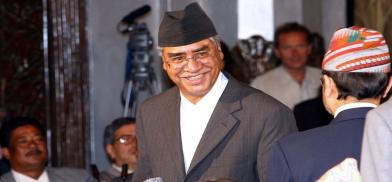Nepal's regime change: Prime Minister Deuba needs to watch out for Beijing's meddling
The upheaval in Nepalese politics over the past few months has occurred following a power tussle within the ruling Communist-led dispensation despite the best efforts of Hou Yanqi, China’s ambassador to Nepal since 2018 to resolve it, writes Lt Gen P. C. Katoch (Retd) for South Asia Monitor

A five-member constitutional bench of Nepal’s Supreme Court on July 12 reinstated the dissolved House of Representatives and ordered Nepali Congress President Sher Bahadur Deuba be appointed as Prime Minister within the next two days. It was a severe blow to both Prime Minister KP Sharma Oli, who was heading a minority caretaker government, as well as President Bidya Devi Bhandari since the apex judiciary ruling dubbed her decision to dissolve parliament as against the spirit of the February 23 order of the highest court.
On May 22, Bhandari dissolved the 275-member lower house for the second time in five months as recommended by Oli and announced snap elections on November 12-13. Nepal’s Election Commission recently announced the schedule for mid-term elections.
The Supreme Court move came after multiple petitions were filed including by an alliance of opposition parties against the dissolution of the House by the President. Earlier on December 20, 2020, President Bhandari dissolved the House and announced fresh elections on April 30 and May 10. But the Supreme Court reversed the decision on February 23, ordering parliament be reinstated.
The upheaval in Nepalese politics over the past few months has occurred following a power tussle within the ruling Communist-led dispensation despite the best efforts of Hou Yanqi, China’s ambassador to Nepal since 2018 to resolve it. Yanqi is known to be close to Oli and apparently Beijing’s efforts, including those through Yanqi, prevailed upon President Bhandari to dissolve the House a second time on May 22 which drew adverse comments from the Supreme Court. The Supreme Court deserves plaudits for upholding justice.
China's role in Nepal's internal politics
Mao Zedong had said. “Tibet is the palm of China and Ladakh, Nepal, Sikkim, Bhutan and NEFA (now Arunachal Pradesh) are its fingers”. To realize that dream, China’s Ministry of Foreign Liaison (NOT SURE) under Mao, recruited and supported the Maoist movement in Nepal and similar movements elsewhere. The long-term aim was to establish a communist regime in Nepal aligned with Beijing, and not friendly with the US and India. The China-sponsored bloody insurgency spanning decades led to 19,000 plus Nepalese getting killed during the civil war and 100,000-150,000 internally displaced.
Oli from the Communist Party of Nepal-Unified Marxist-Leninist (CPN-UML) and Pushpa Kamal Dahal alias Prachanda from the Communist Party of Nepal-Maoist Centre were both leaders during the Maoist insurgency – nurtured and supported by Beijing. China eventually managed to bring the two main communist parties together and installed the Left Alliance government in Nepal. In 2018, the CPN-UML and CPN-Maoist Centre merged to form the Nepal Communist Party (NCP) becoming the largest Communist party in South Asia, and the third-largest Communist party in Asia. However, the power struggle between Oli and Prachanda brought a vertical split in the NCP in 2021.
The Chinese designs suffered another big setback when On 8 March 2021, the Supreme Court ruled the merger of CPN (UML) and CPN (Maoist Centre) to form the Nepal Communist Party (NCP) void ab initio as the name NCP was already allotted to another party.
China has invested heavily both financially and strategically in Nepal - first through the Maoist insurgency and later through communist regimes - to draw it firmly into its sphere. It needs Nepal for its territorial designs and waging an ‘unrestricted war’ on India.
China has been employing hard and soft power to assimilate Nepal through various ways including psychological conditioning, scholarships, training, Confucius Institutes, people-to-people engagement, Maoism, political warfare and buying politicians.
China-Pakistan nexus in Nepal
The China-Pakistan sub-conventional nexus has made surreptitious inroads in Nepal where organizations like the Tehfuzul Madrasa provide safe houses that Pakistan’s spy agency ISI and islamist terrorist organization Lashkar-e-Taiba have been using for running sleeper cells to target India. Their strategy is to lie low, regroup, arrange material and funds before undertaking subversive and sabotage activities through the open Nepal-India border.
A non-communist regime in Kathmandu would not be to the liking of Beijing. Some supporters of former Prime Minister KP Sharma Oli have held protests in Kathmandu against the Supreme Court's order to reinstate the dissolved House of Representatives. Whether Nepal will witness more protests and demonstrations leading to rioting akin to in South Africa by supporters of jailed former President Jacob Zuma only time will tell. The Maoist-Communist muscle power may come into play. In that case, Nepal may have to deploy the army to quell the rioting, as South Africa already has.
But, certainly, China will want a communist regime back in power in the shortest possible time frame, employing every trick up its sleeve. To this end, Sher Bahadur Deuba, who took oath as Prime Minister of Nepal for the fifth time on July 13, needs to remain watchful.
(The author is an Indian Army veteran. Views expressed are personal)










Post a Comment